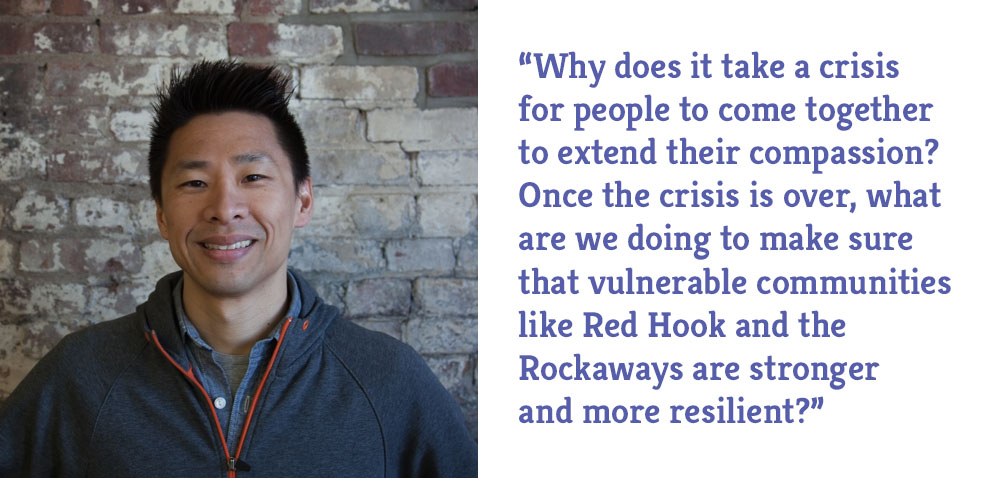Inside Story: What Occupy Sandy’s disaster relief model taught me about organizing to meet our neighborhoods’ greatest needs
Published July 16, 2015
In our new series, “Inside Story,” ioby’s staff talks about what motivates their own work to create positive neighborhood change. ioby’s Operations Director Kerry Huang volunteered for Occupy Sandy in the aftermath of the superstorm, and came away with some powerful lessons about compassion, flexibility, and true community resilience.

October 29, 2012: Hurricane Sandy. Some of you were here when it happened. It was the largest storm New York has ever faced. The superstorm flooded streets, subways, businesses, and houses. It cut power and ruined the homes of tens of thousands. Residents of Coney Island, Red Hook, Canarsie, Staten Island, the Lower East Side and The Rockaways were hit particularly hard. All told, Hurricane Sandy caused New York $19 billion in losses.
The day after the storm hit, the city quickly jumped into disaster relief mode. Just as quickly, the limits of government became apparent. Relief agencies like FEMA simply did not have the capacity to quickly get to all those that needed help in the hardest hit areas. Many were in urgent need of food, water, clothing and shelter, but official relief was slow to come.
In that moment, a decentralized network of grassroots activists became the frontlines of disaster relief.
I volunteered with Occupy Sandy after the storm hit at The Church of St. Luke and St. Matthew in Clinton Hill, where the organizers of Occupy Sandy set up camp. Each day, hundreds of volunteers came by. Some went to Coney Island, The Rockaways, or Red Hook to figure out what residents needed. Some showed up with cars and vans full of donated food, clothing, and supplies to distribute. Some stayed at the church to coordinate volunteers and donations. And some sat and listened to the stories of residents who lost everything — giving hugs, shedding tears with them, and offering words of comfort.

Everywhere I looked, there was compassion in action.
I was also taken aback by how effectively Occupy Sandy leveraged technology to fuel people power. Right behind the last row of pews was Occupy Sandy mission control: a bunch of fold-out tables topped with laptops, powerstrips, and cables. There, the organizers and volunteers huddled and worked around the clock to update occupysandy.net and share google docs with action items. They would tweet and text in real time with activities and needs on the ground. Their efforts allowed the volunteers to quickly and effectively deploy the proper help to the right people and at the right places.
It was an amazing orchestration of people plus tech: donations, hugs, and mic checks harmonized with tweets, texts, and blog posts.
For my part, I made PB&J sandwiches, lots and lots of PB&J sandwiches.
And right in the midst of all this, questions started popping into my head: why does it take a crisis for people to come together to extend their compassion? Once the crisis is over, what are we doing to make sure that vulnerable communities like Red Hook and the Rockaways are stronger and more resilient? When the storm comes again — which we all know it will — how will we be better prepared for it? How can we organize ourselves not just for crisis relief, but for struggles and needs our neighborhoods face everyday?

[via onlytheblogknowsbrooklyn.com]
ioby is working to answer these questions.
Government entities are meant to move slowly, deliberately. Every proposal is thoroughly deliberated and accounted for, and each step requires compliance and consensus on multiple levels by multiple parties involved. For neighborhoods that require adaptive solutions to local needs, slow and deliberate is not always the answer. Whereas individuals, like Occupy Sandy volunteers, can organize on a local level, identify a need, devise a solution, gather support, and make an immediate impact. ioby projects are proving this model: from $543 crosswalk flags that make street crossing safer for children, all the way to a $70,000 2-mile bike lane that revitalizes an entire neighborhood. Through our web platform, ioby project leaders are able to share their ideas to “crowd-resource,” gathering local volunteer power and citizen philanthropy to get their projects off the ground.
People power, empowered by technology.
Fortunately, local governments are paying attention. In cities like Memphis and LA, municipal agencies are launching matching fund campaigns to incentivize local residents to start neighborhood improvement projects for their own community. By working together on these projects from ideas to implementation, governments and residents are experimenting with and investing in strategies that are created by and designed for the neighborhood.
Hopefully, FEMA is also paying attention. They should: with Hurricane Sandy, 7 out of 10 residents got help from their neighbors, whereas only about half received government assistance. Even for those who received assistance, FEMA has sometimes lost track of the them or has even sought to get the money back.
Perhaps smart government officials, who are aware of their agencies’ own limitations in reaction time and ability to scale quickly should consider supporting entities like Occupy Sandy. So when the next disaster strikes, volunteers, donations, and government assistance can be effectively deployed to neighborhoods that need them the most.
People powered disaster relief, empowered by government.
Imagine that.
